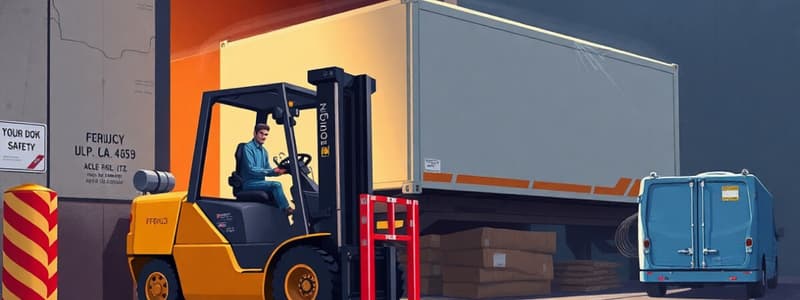Podcast
Questions and Answers
What is the primary reason trucking companies may seek better vehicle restraints than wheel chocks?
What is the primary reason trucking companies may seek better vehicle restraints than wheel chocks?
- To minimize the chances of a fall-through accident (correct)
- To comply with federal regulations
- To reduce downtime during loading
- To enhance fuel efficiency
What should you be cautious about while backing up to a dock?
What should you be cautious about while backing up to a dock?
- The type of truck used
- The positioning of the loading dock
- The weight of the cargo being loaded
- The communication with dock workers (correct)
What is one of the most effective ways to reduce slips and falls at loading docks?
What is one of the most effective ways to reduce slips and falls at loading docks?
- Staying clear of prohibited areas (correct)
- Ignoring safety signs
- Wearing flip-flops to increase comfort
- Rushing to complete loading tasks
How can inclement weather impact safety at a loading dock?
How can inclement weather impact safety at a loading dock?
Why is it important to turn off your truck while at a loading dock?
Why is it important to turn off your truck while at a loading dock?
What should a CDL driver prioritize when lifting cargo?
What should a CDL driver prioritize when lifting cargo?
Which of the following injuries is most commonly associated with loading docks?
Which of the following injuries is most commonly associated with loading docks?
What can result from failure to properly chock or restrain trucks during loading and unloading?
What can result from failure to properly chock or restrain trucks during loading and unloading?
What safety measure is specifically required by OSHA for loading docks that are 48 inches or higher?
What safety measure is specifically required by OSHA for loading docks that are 48 inches or higher?
Which of the following is a primary hazard associated with forklifts on loading docks?
Which of the following is a primary hazard associated with forklifts on loading docks?
What is a key action truck drivers should take to prevent fall-through accidents?
What is a key action truck drivers should take to prevent fall-through accidents?
Why is it essential to communicate while working on a loading dock?
Why is it essential to communicate while working on a loading dock?
What can be considered a 'struck-by' hazard in loading dock environments?
What can be considered a 'struck-by' hazard in loading dock environments?
What type of protection can be used to guard against falls on a loading dock?
What type of protection can be used to guard against falls on a loading dock?
What is a common reason why fall-through accidents occur on loading docks?
What is a common reason why fall-through accidents occur on loading docks?
What should workers do to prevent accidents related to falling loads?
What should workers do to prevent accidents related to falling loads?
Flashcards
Loading Dock Fall Protection
Loading Dock Fall Protection
OSHA requires fall protection on loading docks 48 inches or higher, using guardrails or gates to prevent falls.
Dock Worker Protection
Dock Worker Protection
Open dock doors require protection measures, like gates or barriers, to prevent falls.
Forklift Accidents
Forklift Accidents
Forklifts are common causes of injury at loading docks, due to tipping, falling, or striking workers.
Struck-by Accidents
Struck-by Accidents
Signup and view all the flashcards
Trailer Creep
Trailer Creep
Signup and view all the flashcards
Truck Restraint
Truck Restraint
Signup and view all the flashcards
Loading Dock Safety
Loading Dock Safety
Signup and view all the flashcards
Loading Dock Hazards
Loading Dock Hazards
Signup and view all the flashcards
Loading Dock Injuries
Loading Dock Injuries
Signup and view all the flashcards
Vehicle Restraints
Vehicle Restraints
Signup and view all the flashcards
Backing Up Safety
Backing Up Safety
Signup and view all the flashcards
Safety Signs
Safety Signs
Signup and view all the flashcards
Carbon Monoxide Hazard
Carbon Monoxide Hazard
Signup and view all the flashcards
Safe Lifting Practices
Safe Lifting Practices
Signup and view all the flashcards
Inclement Weather Hazards
Inclement Weather Hazards
Signup and view all the flashcards
Falling Risks at Docks
Falling Risks at Docks
Signup and view all the flashcards
Study Notes
Loading Dock Safety for Truck Drivers
- Fall Protection Requirements: OSHA mandates fall protection on loading docks 48 inches or higher. Open dock doors require worker protection, like guardrails or gates, to prevent falls.
Loading Dock Hazards and Prevention
-
Forklift Accidents: Forklifts are a significant hazard, causing over 90,000 injuries annually. Truck drivers should stay clear of moving forklifts. Falling jacks or dock equipment can also strike workers. Staying alert and avoiding equipment operation zones is crucial.
-
Trailer Creep (Fall-Through Accidents): Unrestrained trucks can roll away, creating gaps. Forklifts or people can fall through, or items can fall on and injure those below. Wheel chocks are often sufficient, but some companies require stronger restraints.
-
Crushed Workers (Communication Fail): Improper communication between drivers and loading dock personnel can lead to workers being crushed between the truck and the dock during backing maneuvers.
-
Slips, Trips, and Falls: These are frequent, especially on wet surfaces or with poor visibility. Signs, barriers, and guardrails are safety features. Proper footwear and awareness are crucial. Inclement weather, like ice and rain, multiplies this risk.
-
Toxic Gas Exposure (Ventilation Issues): Idling trucks in poorly ventilated areas release carbon monoxide. Turn the truck off to prevent exposure.
Proper Truck Restraint
- Wheel Chocks are common restraints, but some companies may require other methods: Using wheel chocks or other restraint systems limits truck rolling.
Other Important Considerations
- Safe Lifting Practices: For CDL holders and workers who are loading goods, following proper lifting techniques is essential to prevent back injuries, especially when handling heavy or awkward loads. Avoid lifting solo, if possible.
- Importance of Communication: Proper communication between drivers and dock workers is vital when maneuvering near the dock.
- Observing Safety Signs: Keep an eye on caution signs (wet floor, danger zones) to avoid injuries. Wearing protective equipment (appropriate foot wear) reduces chances of slips and falls.
- Stay Out of the Way: Keep out of the way of moving equipment like forklifts and remain alert.
Studying That Suits You
Use AI to generate personalized quizzes and flashcards to suit your learning preferences.




